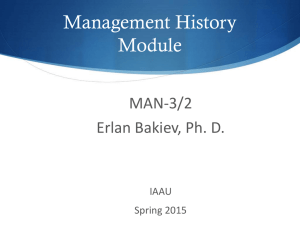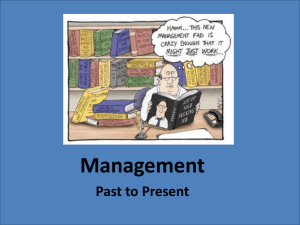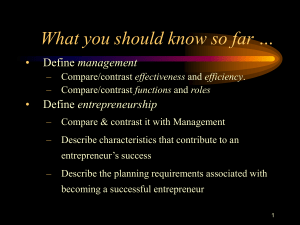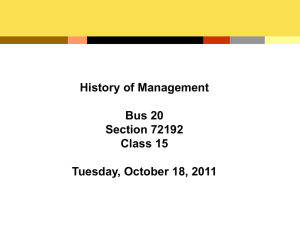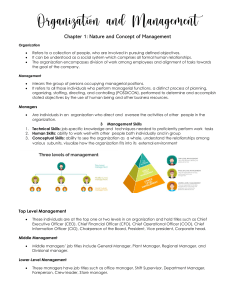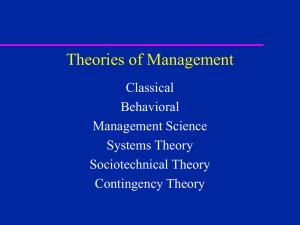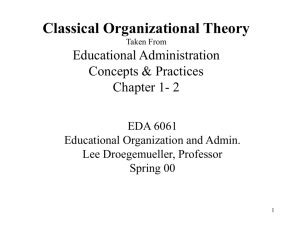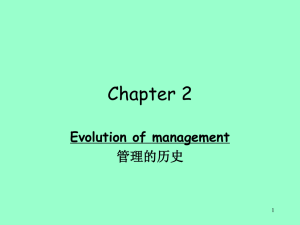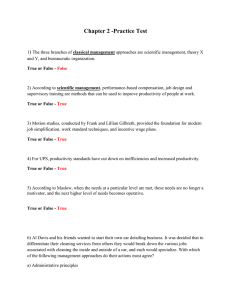History and Evolution of Management Thought
advertisement
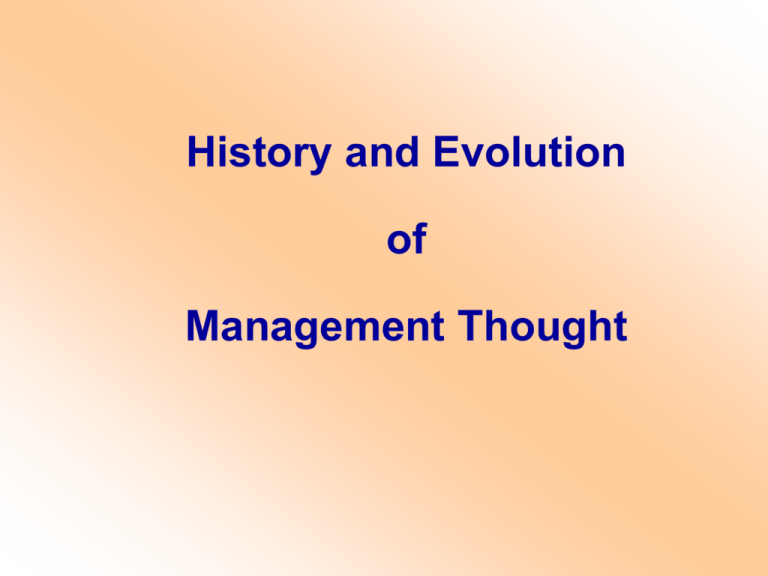
History and Evolution of Management Thought Development of Major Management Theories Pre-classical Classical contritheorists butions Scientific management General administrative theorists Bureaucratic Model Behavioral approach Group Influences Hawthorne studies Maslow’s Needs Theory Theory X & Theory Y Model I versus Model II Values Quantitative approach Management Science Operations managemen t Management Information System Modern Integrative approaches The Systems Theory Contingency Theory Emerging Approaches: Theory Z and Quality Management The Classical Perspective Began around 1900 and continued into the 1930s Traditional or classical management focuses on efficiency Focuses on ways to improve the performance of individual workers One of the major contributors was F.W. Taylor Scientific Management Taylor’s four principles Develop a science for each element of work Scientifically select, train, teach, and develop the worker Cooperate with the workers to ensure that all work is done as per principles Divide work and responsibility equally between management and workers Administrative Management Henri Fayol was the first to identify the five management functions Planning Organizing Leading Coordination Controlling Administrative Management Fayol’s 14 Principles of Management Division of work * Centralization Authority * Scalar Chain Discipline Unity of command * Order * Equity * Stability of tenure Unity of direction Subordination of the individual * Initiative interests to the general interests * Esprit de Corps Remuneration of personnel (unity is strength) Bureaucratic Model Max Weber (1864-1920), analyzed bureaucracy as the most logical and rational structure for large organizations Bureaucracies are founded on legal or rational authority, which is based on law, procedures, rules The Behavioral / Neo-classical Perspective Emerged in the 1920s and dealt with the human aspects of organizations How people in the workplace interact together Interactions between workers affected productivity and hence should be used to positively influence the same The Behavioral Perspective The Hawthorne Studies by Elton Mayo Significant because they demonstrated the important influence of human factors on worker productivity Mayo concluded that individual and social relationships played a major role in shaping workers attitudes and behavior at work The Behavioral Perspective Thus a manager's concern for workers will lead to their increased satisfaction and improved performance Includes the need theories of motivation, such as Maslow's hierarchy of needs, and McGregor's Theory X and Theory Y The Behavioral Perspective Behavioral Scientists focused on human behavior and the study of motivation leadership group dynamics participative management The Quantitative Perspective Management science focuses specifically on the development of mathematical models which help organizations experiment with computers and identify the best way to do things, saving money and time The Quantitative Perspective Operations Management is an applied form of management science that helps organizations develop techniques to produce their products and services more efficiently The Quantitative Perspective Management Information System converts raw data into information and provides the needed information to each manager at the right time, in the needed form Integrating Perspectives The Systems Approach That nothing exists in a vacuum-- that each level of a company affects each other And that each company exists in a system And each system exists in a larger system The Nature of Systems A System in Interaction with its Environment Sources of energy, materials, information, Human Resources Inputs Transforming mechanism Outputs Users Internal Interface Feedback Mechanisms External Interface Feedback Mechanisms Integrating Perspectives The Contingency Approach Contingency perspective argues that universal theories cannot be applied to organizations because each is unique Evaluate your situation, select the best approach for that situation - and make your personal style compatible with the approach Integrating Perspectives The Contingency Approach Emphasizes the fit between organization processes and the characteristics of the situation Calls for fitting the structure of the organization to various possible or chance events Modern Management Thought Contributors: Peter Drucker - MBO William Ouchi - Theory Z Michael Porter - Competitive Strategy Blake & Mouton - Managerial Grid McKinsey’s - 7-S Framework Boston Consulting Group (BCG) - Matrix
